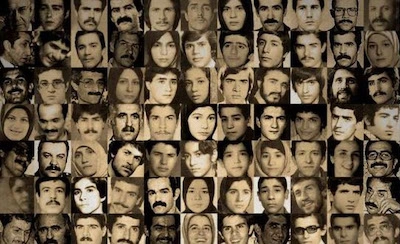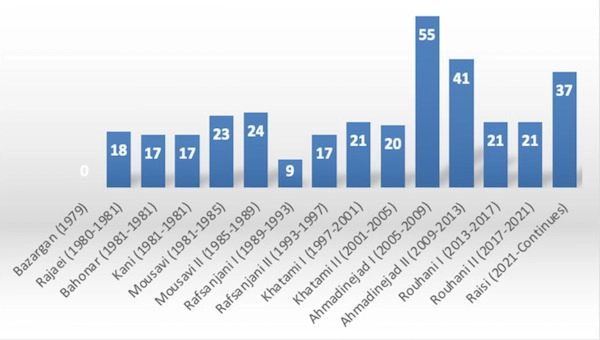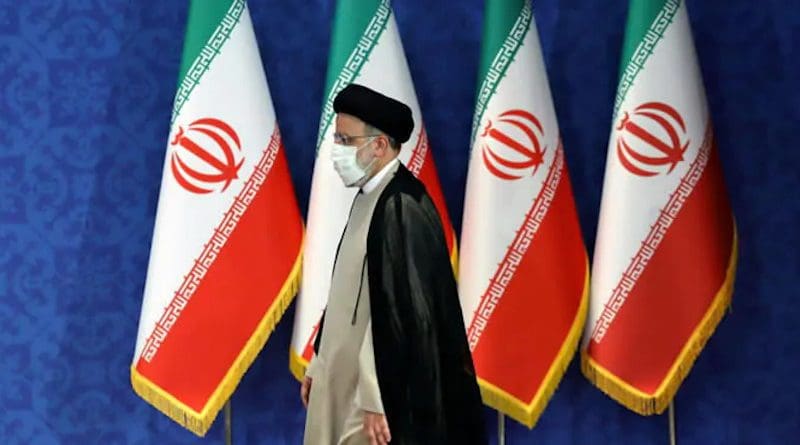Is Raisi Iran’s Supreme Leader In Waiting? Whither Iran? – Analysis
By Ali Alfoneh*
On Friday, June 18, 2021, the Islamic Republic of Iran got not only a new president—Ebrahim Raisi[1]—but a possible successor to Supreme Leader Ayatollah Ali Khamenei. Raisi is seemingly a lackluster bureaucrat anointed president thanks to Khamenei’s electoral engineering and support from the Islamic Revolutionary Guard Corps (IRGC). But it is precisely these quarters that can catapult him to the country’s top spot after Khamenei’s passing, albeit as a largely symbolic figurehead beholden to the IRGC. This, in turn, may complete the Islamic Republic’s gradual transformation from a theocracy into a military dictatorship.
Who Is Raisi?
Seyyed Ebrahim Rais as-Sadati, or Ebrahim Raisi as he is commonly known, was born on December 14, 1960, to a clerical family in the northeastern town of Mashhad, one of Iran’s foremost religious centers. Orphaned at age five, Raisi pursued theological studies, first in Mashhad, and from 1975, at the Theological Seminary in Qom, the other major center of religious learning in Iran. [2]
In his website biography, Raisi claims to have been politicized in January 1978, just a year before the victory of the Islamic Revolution.[3] This is rather surprising. After all, the Qom seminary had been radicalized since the 1960s when Ruhollah Khomeini incited fellow clerics against the Pahlavi regime’s modernization program, which, among other things, expropriated agricultural lands owned by religious foundations and emancipated women.[4]
Raisi’s relatively late politicization can, therefore, be seen as an indicator of early lack of interest in radical politics, also evident in his biography’s indication that his engagement in the “revolutionary struggle” was limited to “sit-down strikes” at Tehran University in the months leading up to the collapse of the Pahlavi monarchy.[5]
Even after the triumph of the revolution in February 1979, Raisi’s political career progressed relatively slowly. Unlike his peers, who immediately rose to high offices in the new regime through revolutionary zeal and connections, Raisi had to work hard to establish connections of his own. He joined political-ideological indoctrination courses organized under the auspices of the charismatic Ayatollah Mohammed Beheshti, future head of Iran’s supreme court but found a position only as an unofficial indoctrination officer at a provincial army garrison.[6]
This inauspicious beginning notwithstanding, Raisi’s bet on the indoctrination classes proved prescient. There he met Ali Qodousi, prosecutor general at the Revolutionary Tribunal who had served prison terms with fellow revolutionaries who would later rise to prominence, notably Khamenei and Iran’s fourth president Akbar Hashemi Rafsanjani.[7] It was Qodousi, who, in February 1981, appointed Raisi assistant prosecutor general in the Tehran suburb of Karaj.[8] And while Beheshti, Qodousi, and other senior clerics effectively weaponized the justice system against real, perceived, and potential political rivals and opponents,[9] it was Raisi and other petty bureaucrats who served as cogs in the repressive machine.
There is no detailed account of this stage in Raisi’s early career, but he must have gained the trust of his superiors. So much so that in the summer of 1988, in his capacity as deputy prosecutor general, he served on a four-member committee administering the summary executions of some 2,800-3,800 political prisoners.[10] The atrocity came in response to an incursion into Iran by the Iraq-based and armed Mojahedin-e Khalq (MEK) shortly after Khomeini “drank from the poisoned chalice” and agreed, on July 20, 1988, to end the 8-year war with Iraq.[11] And while the incursion was easily defeated, Khomeini ordered the summary execution of imprisoned political prisoners, especially MEK members and sympathizers,[12] leaving Raisi and fellow committee members with the grim task of aligning the order with Islamic law and the Islamic Republic’s legislation.[13] Amongst other things, this included deceiving and coercing the prisoners to admit continued loyalty to MEK, which was used against them as “proof” of future intent to engage in armed struggle against the Islamic Republic, and indirectly, God.
The Banality of Evil
This dark side of Raisi’s career became public knowledge only in August 2016 when a secret 1988 recording of the committee’s meeting with Grand Ayatollah Hossein-Ali Montazeri was leaked. In the recording, Montazeri, then Khomeini’s successor-designate and a fierce critic of the executions, is heard saying that the committee members would go down in history as “criminals” who tarnished the image of Khomeini and the Islamic Republic.[14]

Raisi’s dirty work for the regime was rewarded in the 1990s when Khamenei, who had meanwhile succeeded Khomeini as leader of the revolution, promoted Raisi to top positions at the supreme audit court, the judiciary, and the special clerical court—Iran’s equivalent of the “Holy Inquisition.”[15] In these capacities, Raisi engaged in more underhanded activities on behalf of the regime, including the dismissal of cases of rape and sexual harassment of protesters at Kahrizak Detention Center in the wake of the June 2009 presidential elections. Ramin Pourandarjani, the surgeon who had examined the victims, conveniently committed suicide around the time Raisi submitted his report.[16] Similarly, as the head of the special clerical court, Raisi sentenced Ahmad Montazeri, son of the Grand Ayatollah, to twenty-one years in prison for leaking the recording to the BBC of his father chastising the committee members. And while Montazeri was released after just one day in prison and his sentence was suspended due to intercession by senior Qom clerics,[17] the incident demonstrates Raisi’s single-minded ruthlessness.
In a sense, Raisi’s rise in the hierarchy of the Islamic Republic was based on his merits and his services to the regime; yet his marriage to the daughter of Ayatollah Ahmad Alam al-Hoda, a fellow native of Mashhad who held a mid-level position at the Revolutionary Committee in Tehran in the early 1980s,[18] also proved beneficial to Raisi’s later career.
In 2006 and 2016, Raisi and his father-in-law were elected and reelected members of Iran’s Assembly of Experts, which elects the leader of the revolution.[19] In 2016, Hoda, who had served as Mashhad’s Friday prayer leader since 2005, was appointed Khamenei’s personal representative in the Razavi Khorasan province[20] while Raisi was made director of the Astan-e Quds-e Razavi shrine and charitable foundation in Mashahd—one of the Islamic Republic’s foremost religious and economic institutions.[21] These simultaneous promotions meant that northeastern Iran, for all intents and purposes, became the two men’s fiefdom.
Winning the 2021 Presidential Elections
While the trajectory of his career led Raisi to the highest bureaucratic posts, notably Iran’s chief justice,[22] the introverted, guarded, and uncharismatic apparatchik is not a naturally born leader. But neither was Khamenei, who, nevertheless, was twice elected president in the 1980s and succeeded Khomeini as supreme leader in 1989. This is why both men reached out to the ruling elites of the Islamic Republic to engineer their electoral victories.
Khamenei owed his successes to the late Akbar Hashemi Rafsanjani, then parliamentary speaker, and his clerical and technocratic network. Having attained the country’s top spot, Khamenei sought to reduce his dependence on Rafsanjani as well as to surmount the growing popular demand for political and economic reforms by relying ever more heavily on the IRGC.[23]
With an eye to seizing the supreme leadership after Khamenei, Raisi followed in his footsteps by aligning himself with the IRGC. After his unsuccessful challenge of the incumbent Rouhani in the May 2017 presidential elections, Raisi was appointed chief justice, a position he used in his alleged fight against corruption to prosecute political opponents, including Rouhani’s brother, close relatives of cabinet ministers, and rivals of the IRGC’s economic empire.[24]

Reciprocating Raisi’s services, in December 2017, the IRGC capitalized on public dissatisfaction with the government’s economic policy to orchestrate anti-Rouhani protests in Mashhad, in collaboration with Raisi’s father-in-law Hoda. Before long, however, the machination backfired in grand style. Not only did protesters begin to chant slogans against the IRGC’s military engagement in Syria and to hurl insults at the supreme leader, but the protests spread from Mashhad to the rest of the country. In the words of Ali Rabii, a veteran IRGC member who served at the time as cabinet minister and presidential adviser to Rouhani, “a certain political faction that wished to humiliate the cabinet … started a game, the end of which it couldn’t control.”[25]
In a better calculated move, Khamenei rigged the 2021 presidential elections by preventing Raisi from facing any real competition, notably by dissuading Hassan Khomeini, grandson of the Islamic Republic’s founder, from running for president.[26] Meanwhile, the Guardian Council, which interprets constitutional requirements for candidacy, barred the majority of the 592 presidential hopefuls who registered as candidates.[27] Only seven candidates passed the council’s vetting with the rest declared unqualified, including prominent individuals such as former president Mahmoud Ahmadinejad, former parliamentary speaker Ali Larijani, and current vice president Eshaq Jahangiri, who could have defeated Raisi.[28]
In order to avoid splitting the vote, four of the seven qualified candidates withdrew their candidacy a few days before the elections, leaving Raisi to compete against three political lightweights. The best known among them—former IRGC commander Mohsen Rezaei—failed to win a seat in parliament in the 2000 elections, then withdrew his candidacy in the 2005 presidential elections, and lost in the 2009 and 2013 presidential elections. Abdolnasser Hemmati, former governor of the Central Bank of Iran, and Amir Hossein Ghazizadeh Hashemi, a parliamentarian, were political non-entities.
There was also a media component to Khamenei and the IRGC’s rigging of the elections. While the official state media provided wide coverage of Raisi in his capacity as chief justice since 2019, the IRGC intelligence organization and cyber unit effectively prevented any media notice of his role in the mass execution of political prisoners in 1988.[29]
Iranians responded to these maneuvers by boycotting the elections: Only 28.9 million, or just 48.8 percent of Iran’s 59.3 million eligible voters participated in the elections—the lowest participation rate in Iranian presidential elections since 1979.[30] Even more incredible, 3.7 million of the votes cast were invalidated due to a vast protest vote for fictional figures such as the Shiite Mahdi (or messiah), the singer Googoosh, or other individuals not on the ballot. Raisi thus won the race with 61.9 percent of the votes, representing just 30.2 percent of the eligible electorate.[31] The other candidates garnered fewer votes than the number of invalid ballots.
The Road Ahead
Now that he is in the presidential office, Raisi will need to address the same problems and challenges as his immediate predecessor, notably the U.S. sanctions and the restive population seeking economic relief and greater freedoms. Judging by his political record and past conduct, Raisi’s administration will likely adopt an even more confrontational approach abroad, starting with rejection of Washington’s demands for revising the 2015 nuclear agreement, or the Joint Comprehensive Plan of Action (JCPOA) as it is known.[32]
On the domestic front, and in line with his electoral promises,[33] Raisi will likely continue and perhaps expand Ahmadinejad’s populist basic income scheme that proved extremely popular among lower income strata. And while he is unlikely to liberalize the political system, Raisi may yet surprise most observers by easing restrictions on personal freedoms and lessening repression of women, as these issues have caused constant tensions between the regime and its subjects. Reducing harassment of women and young persons for immodest attire and other “violations” of religious codes may endear him to many Iranians who boycotted the elections or cast invalid votes and may help him in the next presidential elections and, indirectly, in the quest for the post-Khamenei supreme leadership.
As for Raisi’s cabinet, not only does its composition reflect the forces that catapulted him to the presidential office, but it also indicates which elite factions and institutions are likely to influence the daily management of state affairs, notably the IRGC and the Astan-e Qods-e Razavi shrine and charitable foundation.[34]
As one of Raisi’s foremost backers, the IRGC has been generously rewarded with key cabinet positions—its second largest government representation in the Islamic Republic’s history, surpassed only by Ahmadinejad’s cabinets. Ahmad Vahidi, former commander of the IRGC’s expeditionary Quds Force (QF), will manage internal security as minister of interior, aided in this effort by Science, Research, and Technology Minister Mohammed-Ali Zolfi-Gol, the new guardian of Iran’s internet. Hossein Amir Abdollahian, a former QF officer and experienced diplomat, may not possess the slickness of his predecessor in the foreign ministry, but he is fully capable of conducting effective diplomacy in close coordination with the IRGC. Management of the COVID-19 pandemic will be entrusted to Health Minister Bahram Ein-Allahi, former head of the IRGC health system. And with Rostam Qassemi at the helm of the roads and urban development ministry, the IRGC’s contracting arms can expect a return to the Ahmadinejad era when they were awarded all major public construction projects in Iran. Finally, IRGC veterans were also vested with the ministries of cultural heritage and sports and youth.
Astan-e Qods-e Razavi shrine bureaucrats constitute the second largest group of institutional representatives in Raisi’s cabinet—the institute’s most substantial representation since the 1979 revolution. While the education and culture ministers represent the spiritual power of the institution, the minister of industry, mining, and commerce and minister of oil represent the economic power of Iran’s equivalent of the Vatican State and indicate a compromise between the IRGC and the Astan-e Qods concerning the institutional sharing of Iran’s wealth.
Conclusion
While Raisi’s electoral victory was not particularly impressive, the forces that orchestrated this victory and form the backbone of his government are likely to pave his path to succeed Khamenei as leader of the revolution. As with the presidential elections, Raisi will neither be the sole candidate nor will play the dominant role in that process, which will most likely be managed by Khamenei and, to an even greater extent, by the IRGC after his passing.
Nevertheless, Raisi (and, for that matter, any other future supreme leader) will be largely a titular figure beholden to the IRGC. This will effectively transform Iran into a military dictatorship, albeit one headed by a turbaned cleric.
*About the author: Ali Alfoneh is the author of Political Succession in the Islamic Republic of Iran: Demise of the Clergy and the Rise of the Revolutionary Guard Corps (The Arab Gulf States Institute, Washington, D.C., 2020).
Source: This article was published by Middle East Forum in its Middle East Quarterly WINTER 2022 • VOLUME 29: NUMBER 1
[1] Donya-ye Eqtesad (Tehran), June 23, 2021.
[2] “Sharh-e zendegi,” Paygah-e Ettelae-Resani-ye Seyyed Ebrahim Raisi (Tehran: n.d.)
[3] Ibid.
[4] Ruhollah Khomeini, Sahifeh-ye Emam (Tehran: Moassesseh-ye Tanzim va Nashr-e Asar-e Emam Khomeini, 2010), vol. 1, p. 78.
[5] “Sharh-e zendegi.”
[6] Ibid.
[7] Masoud Mousavi Ashan, Zendeginameh-ye Shahid Ali Qodousi (Tehran: Markaz-e Asnad-e Enqelab-e Eslami, 2005), p. 15.
[8] “Sharh-e zendegi.”
[9] Iraj Mesdaqi, “Ali Qodousi Dadsetan-e Enqlab va Virangar-e ‘Edalatkhaneh,'” Pezhvak-e Iran (Stockholm), Aug. 18, 2021.
[10] BBC Persian, n.d.; Amnesty International, Dec. 4, 2018.
[11] Khomeini, Sahifeh-ye Emam, vol. 21, pp. 74-100.
[12] Hossein-Ali Montazeri, Khaterat-e Ayatollah Hossein-Ali Montazeri (Los Angeles: Nashr-e Ketab, 2001), pp. 351-2.
[13] BBC Persian, n.d.
[14] Ibid.
[15] “Sharh-e zendegi.”
[16] Jam-e Jam (Tehran), Sept. 13, 2009; Fararu (Tehran), July 9, 2017.
[17] Khabar Online (Tehran), Mar. 4, 2017.
[18] “Sharh-e zendegi“; “Zendeginameh: Seyyed Ahmad Alam al-Hoda,” (Tehran: n.d.)
[19] “Ashnayi ba Majles-e Khobregan” Dabirkhaneh-ye Majles-e Khobregan-e Rahbari (Tehran), n.d.
[20] Daftar-e Hefz va Nashr-e Asar-e Hazrat-e Ayatollah al-Ozma Khamenei (Tehran), Mar. 9, 2016.
[21] Ibid., Mar. 7, 2016.
[22] Ibid., Mar. 7, 2019.
[23] Ali Alfoneh, Political Succession in the Islamic Republic of Iran: Demise of the Clergy and the Rise of the Revolutionary Guards Corps (Washington, D.C.: Arab Gulf States Institute, 2020), pp. 97-133.
[24] Khabargozari-ye Daneshjou (Tehran), Nov. 12, 2019.
[25] Iranian Student News Agency (ISNA,Tehran), Jan. 13, 2019.
[26] Mashregh News (Tehran), Apr. 12, 2021.
[27] Fars News Agency (Tehran), May 25, 2021.
[28] Mashregh News, Apr. 12, 2021.
[29] Radio Farda (Prague), May 19, 2021.
[30] Fars News Agency, June 19, 2021.
[31] Ibid.
[32] Ali Alfoneh, “Iran’s Strategic Lessons Learned,” Arab Gulf States Institute, Washington, D.C., Aug. 10, 2021.
[33] Khaneh-ye Football (Tehran), Aug. 4, 2021.
[34] Fars News Agency, Aug. 11, 2021.

